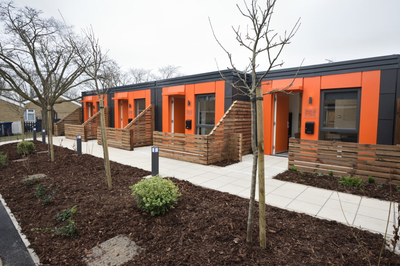There isn’t one solution to ending homelessness and the sector is constantly evolving and responding to ever-changing needs and environments. One of Homeless Link's core roles is to identify and platform innovation in the homelessness sector. Over the last couple of months, we have identified a number of projects focussed on modular housing and in this piece, we explore the opportunities, risks and future of the practice. Is modular housing a solution for ending homelessness?
What are the different kinds of modular housing?
There is a growing industry of modular housing, and in the UK volumetric MMC is the only category to have a Trade Group - Make UK Modular. Their tagline:
“Greener, better, faster. Modular’s role in solving the housing crisis.”
A report from this group stated that there was capacity to build 20,000 low carbon, energy efficient homes across England by 2025. The key word in this sentence, is home and seems to be one of the most controversial aspects of the use of modular housing within the homelessness sector.
Modular housing has taken on many different forms in providing both permanent and temporary housing solutions for a wide range of people. In the USA, people who are far away from experiencing homelessness are investing in modular:
Image is of a large, four-bedroom family home.
And large is the point, because space standards matter when it comes to modular. Space standards are not building regulations, but they do remain as a technical planning standard and according to the national space standard, the minimum gross internal floor space for a one-bedroom flat for one person is 37m2.
Although modular housing absolutely has the potential to provide a permanent and space compliant home, the reality is that most of the modular housing being used for people experiencing homelessness is something quite different.
Typically, the modular housing within the sector is temporary, with an expectation of move-on within a specific timescale and is smaller than the national space standard at 24m2 or less.
According to the Centre for Homelessness Impact’s Modular Housing report (2022), there are some 33 schemes across 22 local authority areas in the UK. Interestingly, this report separates the schemes into two categories: 27 using prefabricated modular units (or volumetric MMC) and six, being converted shipping containers.
Already, we see a blurring of lines about what is meant by modular housing in the homelessness sector. ~With the above definitions in mind, a converted shipping container isn’t actually modular and would fall in a category of its own. What the schemes identified had in common though, was an intention to provide temporary housing solutions as an alternative to traditional hostels or temporary accommodation, and as a step toward permanent housing.
In Cambridge, the ‘Mods’ are used for people with medium to high support needs and for whom traditional hostel accommodation is not working. The Mods are not viewed as a replacement to hostels but add an alternative housing solution for a small group of people who need a different offer.
Interestingly, one of the conclusions drawn from the evaluation was around the point of temporary accommodation and that several residents did not want to move-on and would have liked this modular housing to be their permanent home.
In addition to Jimmy’s Cambridge, HPI has identified a further eight modular housing schemes, all of which are providing a similar offer to Jimmy’s Cambridge but with some differences. This includes Centrepoint’s recent announcement to launch an ambitious 300 modular homes for young people aged 18-25 across Manchester and London.
Based on a review of these projects and associated evaluations, the three biggest benefits of temporary modular housing seem to be:
- Costs and the build affordability, with one unit at Jimmy’s Cambridge costing around £25k, although increases to building material costs has affected this.
- Quick turnaround times from inception to move-in for people experiencing immediate homelessness or rough sleeping
- A better alternative to some hostel accommodation for some people, where there are shared facilities/communal areas
But are there risks?
Not all temporary modular housing is made equally, and the quality of provision is an issue. The Centre for Homelessness Impact’s (CHI) report found that:
“There are concerns about the quality of the design of some of the schemes, the distance of some sites from local amenities, and the lack of onsite communal facilities, particularly in schemes that house children.”
There is also a concern around size. With no requirement to meet the national space standard, how small is too small? In the LGA Modular Housing report (2017), examples of container housing such as Snoozebox were given, which are as small as 7m2.
A resident of Jimmy’s Cambridge said:
“For one person it's [the size] fine. […] I was living in a tent before so it’s fine for me. (Resident at Site 2).”
In webinar hosted by CHI on modular housing, a professional from a modular housing company said:
“We wouldn’t get away with 24m2 homes for general needs tenancies.”
Jimmy’s Cambridge explained that the space question has not really been an issue for them, with residents being very happy with their Mod, some even preferring a smaller space as it brings with it a sense of safety. However, there are some elements which are crucial to making their modular housing scheme work, such as:
- Small sites with a maximum of 4-6 units
- In-house maintenance to respond to repair needs
- Relationship-based and trauma-informed support
Where modular is used as temporary shelter, standards are needed
Firstly, where modular is used as transitional or temporary housing, our sector must agree its red lines on standards, perhaps even a set of principles to guide some consistency for practice across the country and ensure that all projects, like Jimmy’s Cambridge, can be celebrated.
Where modular could provide good quality permanent homes really end homelessness
Secondly, however good temporary modular housing projects are, it is undeniable that we are limiting the potential of the innovation. The current funding model is heavily weighted toward temporary rather than permanent accommodation for people experiencing rough sleeping. However, we do see alternative models such as Housing First, providing permanent housing and it may be that modular has a role to play.
A country free from homelessness, means everybody has a place to call home and that home could indeed be modular.
Some FAQs about Modular Housing
Are there examples of modular housing transitional communities?
Yes, there are now several different transitional communities in England.
Solo Haus - including Haringey Council - and Bristol Council
How much does a typical modular housing unit cost?
The cost of a fully installed modular home depends on many different factors such as specification and location. The typical turnkey cost is approximately £2,500 - £3,500 per square metre.
How many modular housing units is ideal for one site?
It is important to consider the transitional community as a whole, which may impact the number of units on one site. Jimmy’s Cambridge, who work with people experiencing multiple disadvantages, would advise small communities of 4-6 units. But, where modular homes are being used as temporary accommodation for families, there are larger communities, such as those in Cardiff -
Is support provided in modular housing?
Modular housing can be used for lots of different populations of people experiencing homelessness. It is important to consider who will occupy the modular housing units and to ensure that an appropriate level of support is provided. Working with other organisations, support can be provided for those living in the homes. For models like Jimmy’s Cambridge, support is an integral part of the transitional community and is provided on-site, 24 hours per day.
How long does it take to build modular housing?
The time taken to build the homes on site entirely depends on how much of the work can be completed offsite before delivery. A fully fitted modular home, complete with a kitchen and bathroom installed in the factory, can be placed onto site in hours, so if all the services are ready to hook up on a plug-and-play basis, the homes could be ready for occupation in days. For a modular scheme, the completion time is likely to be governed by the peripheral works, including the addition of external components (e.g. external staircases/lifts/balconies) or the degree of fitting out and landscaping required. Time savings associated with MMC construction are achieved by twin-tracking construction in the factory, with groundworks on site. In addition, modular solutions often enable the use of screw pile foundations which are quicker to install than traditional concrete foundations.
What sites are used for MMC homes?
Being just a way of building, MMC modular homes can be used to deliver homes on any sites suitable for housing, whether temporarily or permanently. The ability to manufacture elements of the build offsite and then assemble them onsite, helps deliver homes on highly constrained or sensitive sites, where traditional construction methods would be too disruptive. The ability to relocate modular homes also creates opportunities to build on sites that are only available temporarily. Some examples include:
- Using land owned by the local authority, such as car parks
- Land provided by churches, as with Jimmy’s Cambridge
- Repurposing existing buildings, such as unused office spaces
- Meanwhile sites – areas of land that are temporarily vacant and awaiting long-term development or re-development
What is the lifespan of MMC?
The lifespan of MMC products varies depending on the manufacturer. A lot of good quality MMC housing is accredited by assurance schemes such as BOPAS. Some manufacturers have guarantees in place for 60 years or more, and with some manufacturers, as with traditional build, you might expect a home to last 100 years or more.
Can the modular home be moved?
Yes, this is one of the key advantages of MMC. For those systems designed to be movable (also known as demountable) the unit is manufactured offsite and then placed onto the chosen site. The unit can then be moved and placed onto an alternative site, when needed.
What do you think?
The HPI is keen to explore this topic further, both on the need for standards around temporary modular housing and the potential of modular in providing permanent homes for people experiencing homelessness. If you are involved with modular housing and would like to join a roundtable discussion, please contact alex.smith@homelesslink.org.uk.
Useful LInks
In writing this spotlight these are the sources we have used:
Article on MMC categories from kopi.
Housing Digital guide to modular housing
MakeUK article on modular housing
Big Issue article on modular housing
UK Government standard on nationally described space
Centre for Homelessness Impact, Modular housing insights
Cambridge Centre for Housing and Planning Research: study of modular housing
Arcadis Report. Local Authority Modular Housing Provision Models






